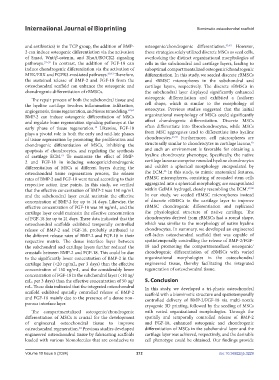Page 220 - IJB-10-5
P. 220
International Journal of Bioprinting Biomimetic osteochondral scaffold
and antibiotics) in the TCP group, the addition of BMP- osteogenic/chondrogenic differentiation. 43,45 However,
2 can induce osteogenic differentiation via the activation these strategies solely utilized discrete MSCs as seed cells,
of Smad, Wnt/β-catenin, and RhoA/ROCK2 signaling overlooking the distinct organizational morphologies of
pathways. 57–59 In contrast, the addition of FGF-18 can cells in the subchondral and cartilage layers, leading to
induce chondrogenic differentiation via the activation of suboptimal compartmentalized osteogenic/chondrogenic
MEK/ERK and FGFR3-mediated pathways. 60,61 Therefore, differentiation. In this study, we seeded discrete rBMSCs
the sustained release of BMP-2 and FGF-18 from the and rBMSC microspheres in the subchondral and
osteochondral scaffold can enhance the osteogenic and cartilage layers, respectively. The discrete rBMSCs in
chondrogenic differentiation of rBMSCs. the subchondral layer displayed significantly enhanced
The repair process of both the subchondral tissue and osteogenic differentiation and exhibited a fusiform
the hyaline cartilage involves inflammation infiltration, cell shape, which is similar to the morphology of
angiogenesis, tissue regeneration, and tissue remodeling. 62,63 osteocytes. Previous studies suggested that the initial
BMP-2 can induce osteogenic differentiation of MSCs organizational morphology of MSCs could significantly
and regulate bone regeneration signaling pathways at the affect chondrogenic differentiation. Discrete MSCs
18
early phase of tissue regeneration. Likewise, FGF-18 often differentiate into fibrochondrocytes, while MSCs
plays a pivotal role in both the early and mid-late phases from MSC aggregates tend to differentiate into hyaline
of tissue regeneration by promoting the proliferation and chondrocytes. 23,30 Furthermore, cell microspheres are
65
chondrogenic differentiation of MSCs, inhibiting the structurally similar to chondrocytes in cartilage lacuna,
apoptosis of chondrocytes, and regulating the synthesis and such an environment is favorable for obtaining a
of cartilage ECM. To maximize the effect of BMP- hyaline chondrocyte phenotype. Specifically, the native
19
2 and FGF-18 in inducing osteogenic/chondrogenic cartilage lacunae comprise rounded hyaline chondrocytes
differentiation of MSCs at different layers during the and exhibit a spherical morphology encapsulated by
66
osteochondral tissue regeneration process, the release the ECM. In this study, to mimic anatomical features,
rates of BMP-2 and FGF-18 were tuned according to their rBMSC microspheres, consisting of rounded stem cells
respective action time points. In this study, we verified aggregated into a spherical morphology, are encapsulated
that the effective concentration of BMP-2 was 150 ng/mL within GelMA hydrogel, closely resembling the ECM. 67,68
and the subchondral layer could maintain the effective In our study, we seeded rBMSC microspheres instead
concentration of BMP-2 for up to 14 days. Likewise, the of discrete rBMSCs in the cartilage layer to improve
effective concentration of FGF-18 was 50 ng/mL, and the rBMSC chondrogenic differentiation and replicated
cartilage layer could maintain the effective concentration the physiological structure of native cartilage. The
of FGF-18 for up to 21 days. These data indicated that the chondrocytes derived from rBMSCs had a round shape,
osteochondral scaffolds exhibited temporally controlled which was similar to the morphology of native hyaline
release of BMP-2 and FGF-18, probably attributed to chondrocytes. In summary, we developed an engineered
the different release rates of BMP-2 and FGF-18 in their cell-laden osteochondral scaffold that was capable of
respective matrix. The dense interface layer between spatiotemporally controlling the release of BMP-2/FGF-
the subchondral and cartilage layers further reduced the 18 and promoting the compartmentalized osteogenic/
crosstalk between BMP-2 and FGF-18. This could be due chondrogenic differentiation of rBMSCs with varied
to the significantly lower concentration of BMP-2 in the organizational morphologies in the osteochondral
cartilage layer (<20 ng/mL, per 3 days) than the effective engineered tissue, thereby facilitating the integrated
concentration of 150 ng/mL, and the considerably lower regeneration of osteochondral tissue.
concentration of FGF-18 in the subchondral layer (<10 ng/
mL, per 3 days) than the effective concentration of 50 ng/ 5. Conclusion
mL. These data indicated that the integrated osteochondral In this study, we developed a tri-phasic osteochondral
scaffold exhibited spatially controlled release of BMP-2 scaffold with a biomimetic structure and spatiotemporally
and FGF-18 mainly due to the presence of a dense non- controlled delivery of BMP-2/FGF-18 via multi-nozzle
porous interface layer. cryogenic 3D printing, followed by the seeding of MSCs
The compartmentalized osteogenic/chondrogenic with varied organizational morphologies. Through the
differentiation of MSCs is crucial for the development spatially and temporally controlled release of BMP-2
of engineered osteochondral tissue to improve and FGF-18, enhanced osteogenic and chondrogenic
osteochondral regeneration. Previous studies developed differentiation of MSCs in the subchondral layer and the
64
engineered osteochondral tissue by fabricating scaffolds cartilage layer was achieved, respectively, and the desirable
loaded with various biomolecules that are conducive to cell phenotype could be obtained. Our findings provide
Volume 10 Issue 5 (2024) 212 doi: 10.36922/ijb.3229

